Japan-United States of America Relations
Prime Minister Shinzo Abe's Visit to the United States of America
May 3, 2015
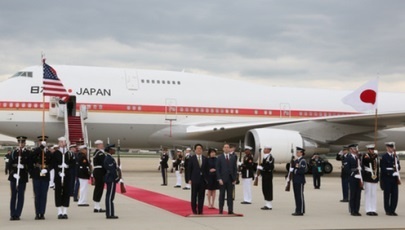 Photo: Cabinet Public Relations Office
Photo: Cabinet Public Relations Office
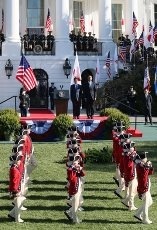 Photo: Cabinet Public Relations Office
Photo: Cabinet Public Relations Office
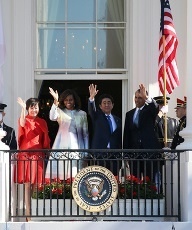 Photo: Cabinet Public Relations Office
Photo: Cabinet Public Relations Office
From April 26 to May 2, Prime Minister Abe visited the United States, which was the first official visit by a Prime Minister of Japan to the United States in nine years. The outline of the visit is as follows.
- 1.Significance of the Visit to the United States
- 2. Overview of the Main Events
- 3.Details of the Visits to Each City
1.Significance of the Visit to the United States
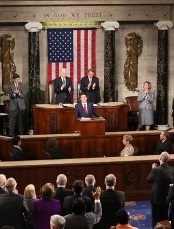 Photo: Cabinet Public Relations Office
Photo: Cabinet Public Relations Office
 Photo: Cabinet Public Relations Office
Photo: Cabinet Public Relations Office
(1) Sending a positive message on the progress of the Japan-U.S. relations in 70 years since the end of World War II and their future
During this visit in the year marking 70 years since the end of World War II, Japan and the United States confirmed how the Japan-U.S. Alliance has contributed to peace and stability in the Asia-Pacific region and the world in the postwar period. Both countries also demonstrated their strong intention to continue to contribute hand-in-hand to the region and the world based on their shared fundamental values such as freedom, democracy, human rights, and the rule of law. These points were emphasized particularly by Prime Minister Abe’s address to a joint meeting of the U.S. Congress, which was made for the first time in the history as a Prime Minister of Japan.
(2) Further strengthening the Japan-U.S. Alliance and affirming the bond between the two countries’ leaders
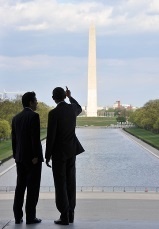 Photo: Cabinet Public Relations Office
Photo: Cabinet Public Relations Office
 Photo: Cabinet Public Relations Office
Photo: Cabinet Public Relations Office
Prime Minister Abe’s official visit to the United States was held following President Obama’s state visit to Japan last year. In the Japan-U.S. Summit Meeting, the two leaders confirmed the progress on the bilateral issues. They also confirmed their coordination in response to regional affairs and global issues, and reaffirmed that they will further strengthen their cooperation in the future. Furthermore, the personal relationship of both leaders was further strengthened through the visit, with the President himself guiding the Prime Minister to the Lincoln Memorial and the pleasant exchanges of opinions in a relaxed atmosphere during the official banquet.
(3) Promoting the multi-layered Japan-U.S. relations toward the future
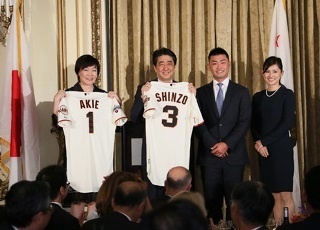 Photo: Cabinet Public Relations Office
Photo: Cabinet Public Relations Office
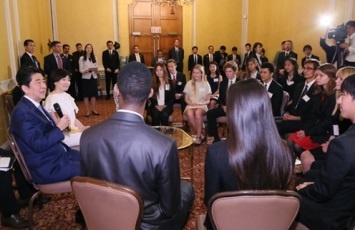 Photo: Cabinet Public Relations Office
Photo: Cabinet Public Relations Office
Prime Minister Abe visited Boston, San Francisco, and Los Angeles in addition to the capital Washington DC. In each of these cities, Prime Minister Abe interacted with a wide range of people, including students, intellectuals, and business people. Prime Minister Abe reaffirmed the deepening in cooperation between Japan and the United States, not only in the field of politics but also in the economic, cultural, and educational fields, as well as his intention to build even broader Japan-U.S. relations in the future. Moreover, he further strengthened ties with Japanese-Americans, who are important bonds between Japan and the United States.
2. Overview of the Main Events
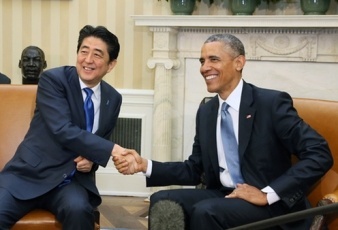 Photo: Cabinet Public Relations Office
Photo: Cabinet Public Relations Office
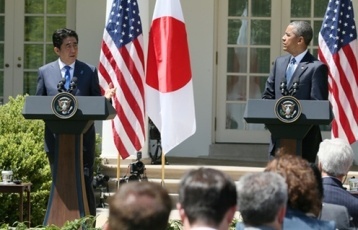 Photo: Cabinet Public Relations Office
Photo: Cabinet Public Relations Office
(1) Japan-U.S. Summit Meeting (April 28)
Both leaders reaffirmed the role that the Japan-U.S. Alliance plays for peace and prosperity in the Asia-Pacific region and the world. On the occasion of this meeting, the following documents were issued: 1) the Japan-U.S. Joint Vision Statement; 2) Japan-U.S. Joint Statement on the Treaty on the Non-Proliferation of Nuclear Weapons (NPT); and 3) Fact Sheet: Japan-U.S. Cooperation for a More Prosperous and Stable World.
Regarding bilateral issues between Japan and the United States, Prime Minister Abe and President Obama confirmed the further strengthening of the Alliances’ deterrence and response capability under the new Guidelines for Japan-U.S. Defense Cooperation announced at the Japan-U.S. “2+2” meeting held one day before the Summit Meeting. They also confirmed that they will steadily advance the realignment of U.S. forces in Japan. Furthermore, the two leaders welcomed the progress made in the bilateral consultation of TPP between Japan and the United States and agreed to lead the entire negotiations toward an early conclusion.
With regard to regional affairs, Prime Minister Abe and President Obama concurred that placing Japan and the United States at the core, two countries should maintain a free and open Asia-Pacific region based on the rule of law, and that involve China therein. Both leaders also confirmed their opposition to any attempt by China to unilaterally change the status quo. Furthermore, they confirmed that they would coordinate their responses in responding North Korea, Ukraine, and Iran, among others.
Prime Minister Abe and President Obama also exchanged views on a range of global issues, including climate change and measures to address infectious diseases.
(2) Address to a Joint Meeting of the U.S. Congress (April 29)
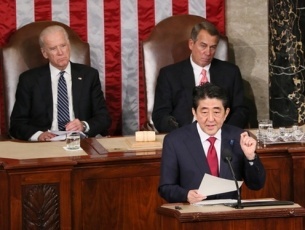 Photo: Cabinet Public Relations Office
Photo: Cabinet Public Relations Office
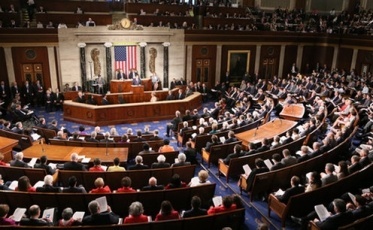 Photo: Cabinet Public Relations Office
Photo: Cabinet Public Relations Office
For the first time in the history as a Prime Minister of Japan, Prime Minister Abe made an address to a joint meeting of the U.S. Congress. As his fundamental message, he reviewed that Japan and the United States, countries which had previously waged war against each other, reconciled after the war and became robust allies, making contributions to peace and prosperity in the region and the world, and emphasized the bond that has been forged between Japan and the United States for 70 years since the end of the war.
3.Details of the Visits to Each City
 Photo: Cabinet Public Relations Office
Photo: Cabinet Public Relations Office
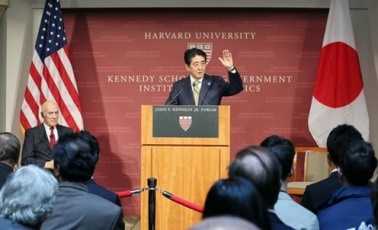 Photo: Cabinet Public Relations Office
Photo: Cabinet Public Relations Office
(1) Boston (April 26 and 27)
Prime Minister Abe visited the John F. Kennedy Presidential Library and Museum which has exhibitions on Former President Kennedy, and reaffirmed the long and deep history between Japan and the United States. The Prime Minister and conducted a frank exchange of views with a small group of people at Secretary of State John Kerry’s private residence. Prime Minister Abe also engaged in a frank dialogue with students of Harvard University, where he stressed the strength of the ties between Japan and the United States. At the Massachusetts Institute of Technology (MIT), through an exchange of opinions with experts and entrepreneurs engaging in the world’s most advanced research and innovation, Prime Minister Abe explained Japan’s stance in which creation of innovation, entrepreneurships, and venture support constitute one of the pillars of the country’s growth strategy.
(2) Washington DC (April 27 to 30)
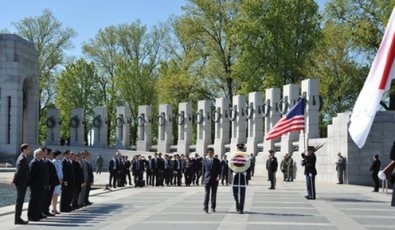 Photo: Cabinet Public Relations Office
Photo: Cabinet Public Relations Office
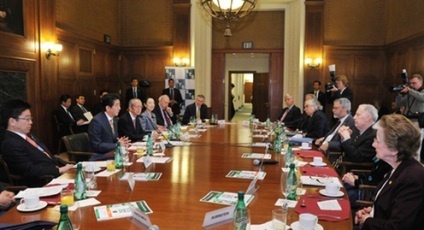 Photo: Cabinet Public Relations Office
Photo: Cabinet Public Relations Office
In addition to official events including the welcoming ceremony, the Japan-U.S. Summit Meeting, the official banquet and the address to the Congress, Prime Minister Abe visited the Arlington National Cemetery and the National World War II Memorial and paid his homage to the victims of World War II. Additionally, at the Holocaust Memorial Museum, Prime Minister Abe met with people whose lives were saved by the visas issued by Chiune Sugihara, and reaffirmed more strongly that such tragedy as the Holocaust shall never be repeated. Furthermore, Prime Minister Abe attended a symposium on security held by the Sasakawa Peace Foundation, roundtable talks with the U.S. Chamber of Commerce, and a breakfast meeting with members of the STS forum presenting Japan’s basic policies. Moreover, Prime Minister Abe hosted a gala dinner inviting those related to the Japan-U.S. relations and conveyed his gratitude them for their contributions.
(3) San Francisco (April 30 to May 1)
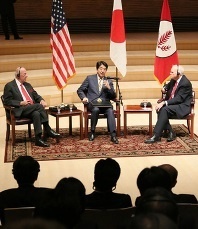 Photo: Cabinet Public Relations Office
Photo: Cabinet Public Relations Office
 Photo: Cabinet Public Relations Office
Photo: Cabinet Public Relations Office
At the West Coast’s hub of innovation, entrepreneurship, and venture support that moves the United States and the world, Prime Minister Abe emphasized Japan’s policies in which these elements constitute a pillar of the country’s growth strategy. Through participation in a symposium attended by intellectuals from Stanford University, entrepreneurs and business people actively working in Silicon Valley and other places, as well as visits to companies, Prime Minister Abe expressed his intention to promote exchanges between Japan and Silicon Valley in the future. In addition, Prime Minister Abe promoted Shinkansen (bullet train) technology at the highest level by receiving the courtesy call by Governor of the State of California Edmund G. Brown Jr. and trying a Shinkansen simulator together.
(4) Los Angeles (May 1 to 2)
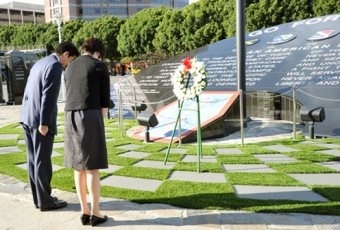 Photo: Cabinet Public Relations Office
Photo: Cabinet Public Relations Office
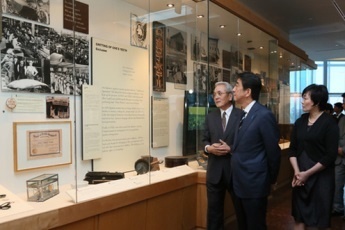 Photo: Cabinet Public Relations Office
Photo: Cabinet Public Relations Office
Prime Minister Abe laid a wreath at the Go For Broke Monument which commemorates Japanese-American World War II soldiers, and visited the Japanese American National Museum, thereby strengthening the deep bonds that exist between Japan and Japanese-Americans. Furthermore, in informal discussions with participants in the Kakehashi Project, the Prime Minister expressed his hope they would become a bridge (kakehashi) between Japan and the United States in the future. Prime Minister Abe also attended the Japan-U.S. Economic Forum with influential business people from Japan and the United States, where he called for further mutual investment by Japan and the United States.

